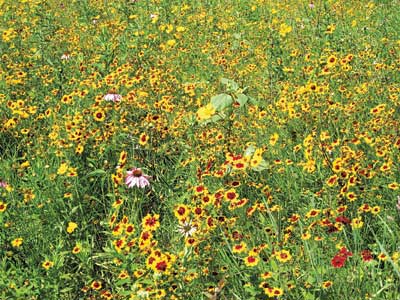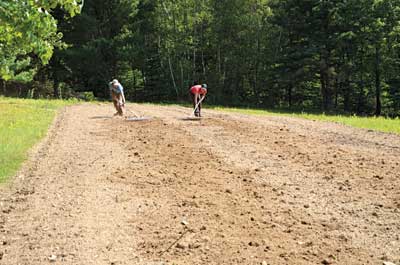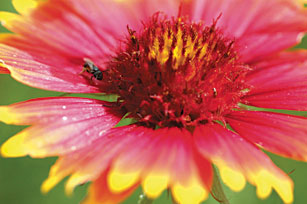 |
| Dense floral resources of a pollination reservoir in Maine. Photo by Eric Venturini, The University of Maine |
 |
| Eric Venturini and Audrey Maddox rake a seed bed free of debris before seeding a wildflower mix. Photo by Margaret McCullough, The University of Maine |
 |
| A tiny black bee visits Gaillarida pulchella in a pollination reservoir in Maine. Photo by Eric Venturini, The University of Maine |
By Sue Smith-Heavenrich
If you want to increase pollination and fruit set in your blueberries, plant flowers. It’s working for Doug Van Horn, who produces 14 acres of blueberries in Montville. The wildflower strips were part of a research project, he says. Eric Venturini, a graduate student at the University of Maine at the time, wanted to see whether planting flower strips would increase bee populations and flower visits in blueberry patches, and the margins of Van Horn’s field provided an ideal study site.
“There was an area that was producing poorly,” Van Horn recalls, so Venturini cleared and rolled and planted coreopsis, asters and purple coneflowers in a half-acre strip. A couple of years later, Van Horn reseeded and lightly tilled the strip. “Last year I got a good population of pollinators,” he says.
Creating wildflower patches – called pollination reservoirs in the scientific literature – isn’t a novel idea. A study in South Africa found that small flower patches in mango orchards significantly increased pollinator visits to flowers and resulted in higher yields. Similar results have been shown for beans, peppers and strawberries.
The contribution of pollination reservoirs varies with the complexity of the surrounding landscape, says Cornell researcher Heather Grab. She is examining the effects of wildflower strips on strawberries in the Finger Lakes region of New York. Planting flower patches has a more pronounced effect on simple agricultural landscapes – fields with more than 40 percent of the land in row crops or perennial crops over a 750-meter radius – than on a complex landscape.
Eric Venturini, now an assistant research scientist in the school of biology and ecology at the University of Maine, is continuing the work he started in Van Horn and others’ blueberry patches. He recently started a consulting service, Grow Wild Bees, to help blueberry and other growers. Flower strips are important, he says, because not only do they attract more bees, but they attract a broader diversity of bees to the berry fields. Diversity is like pollinator insurance – it provides a buffer when weather, disease or some other factor affects some of the bees.
Meet the Berry Bees
About 276 species of bees live in Maine. Of those, says Venturini, close to 100 are associated with blueberries. They include at least a dozen species of bumblebees (family Apidae) ranging in size from under one-half inch to about an inch long. Like honeybees, bumblebees are social, but their colonies are smaller. They usually nest in abandoned rodent burrows in the ground, but you can also find them nesting in a cavity in a moldering hay bale or stump.
Digger, or miner bees (family Andrenidae) are small to medium-sized bees that nest in the soil, often hiding their nest entrances beneath leaf litter. They are solitary bees, active in the spring, and are the most frequent pollinators of blueberries.
Sweat bees (family Halictidae) are small green or brown bees with stripes. They are usually the most abundant group found on farms and build their nests in the ground or in rotten wood. They love to visit black-eyed Susans, sunflowers and asters.
Cellophane or plaster bees (family Colletidae) are named for their behavior of lining their brood cells with a cellophane-like substance. Yellow-faced plasterers are relatively hairless and look a bit like wasps. They nest in twigs and plant stems. Others are quite hairy, with conspicuous white stripes on their abdomen, and nest in the soil.
Leafcutter and mason bees are both in the family Megachilidae. Leafcutters are medium-sized black bees, often with a striped abdomen. They have relatively large heads with large mouthparts for cutting leaves to construct nest cells in hollow plant stems. Mason bees are small to medium-sized metallic blue or black bees with white hair on their thorax. They also live in hollow plant stems but use mud for nest-building.
Creating a Bee Habitat
Increasing bee population and diversity is important, but how much land should a grower sacrifice to bring in bees? Most fact sheets recommend that 30 percent of farmland be maintained as natural habitat. But that is based on a broad definition of “natural habitat” says Venturini – not on the pollen- and nectar-rich wildflower strips. Some of the successfully established wildflower strips adjacent to highbush blueberry fields in Michigan were only 2 percent of the field size, and farmers realized a payback on increased yields in four to five years.
In his own research on lowbush berries in Maine, Venturini showed that pollination reservoirs representing only 1 to 5 percent of the cropped area were enough to increase fruit set by roughly 10 percent after three years. In Van Horn’s case, the wildflowers were planted on a half-acre of marginal land. Still, Venturini’s bee counts showed good flower visitation across all of the berries.
Regardless of its size, Venturini emphasizes the importance of preparing and maintaining the wildflower strip. First you need to get rid of existing vegetation by tilling and exhausting the seed bank. Then – especially important for blueberry growers – make sure the soil pH is suitable for flowers. That might mean adding lime.
Flower selection is important. Plan for at least three kinds of plants to be blooming at the same time at any point over the season, and choose flowers that will appeal to a variety of bees. That means have flowers with varying lengths and complexity of corollas. (Corolla is the collective term for petals on a flower.) While native plants are ideal, don’t overlook non-native plants that might be more appropriate for your situation. And choose plants that are suited to your site and that will establish successfully with the level of care you intend to provide.
Think about your farm, says Venturini. A mixed vegetable farmer might plant something that serves a dual purpose, such as buckwheat or clover, providing resources for bees as well as cover crops. Someone planting a permanent wildflower strip might want cut-flowers, and so might include monarda and bachelor button. “Lupine is a great early spring flower for bumble bees,” says Venturini. He’s also seen lots of mason and leafcutter bees on lupine. “And don’t forget New England asters for late season blooms,” he adds.
Before planting, work the soil to ensure a fine seedbed so that the small-seeded wildflower seeds have good soil contact for germination. After sowing, thoroughly compact soil and give it a good watering to maximize germination and establishment. For maintenance, mow your “bee pasture” once each fall after the wildflowers have finished flowering and set seeds.
Creating bee habitat isn’t cheap, but Venturini says growers can apply for cost-sharing through federal programs. The Natural Resources Conservation Service of Maine (nrcs.usda.gov/wps/portal/nrcs/site/me/home) provides information about Pollinator Habitat Enhancement Plans.
Resources for Growers
“Enhancing Wild Bees for Crop Pollination: Sowing Bee Pasture for New England’s Wild Lowbush Blueberry” by University of Maine Cooperative Extension (extension.umaine.edu).
The Xerces Society (xerces.org) has many resources on pollinator conservation, and produced videos for the integrated crop pollination project (icpbees.org/new-video-series-planting-flowering-habitat-for-bees), including “Pollinator Habitat 101” and “Five Steps to Success for Establishing Perennial Wildflower Plantings for Pollinators.”
Grow Wild Bees specializes in wild bees and wild bee pollination in cropping systems. Contact [email protected] or 207-478-7612.
Johnny’s Selected Seeds (johnnyseeds.com) and Applewood Seed Company (applewoodseed.com) provide “bee feed” seed mixes.
Flowers for a Maine Bee Pasture
(P = perennial; B= biennial; A = annual)
Agastash foeniculum – anise hyssop (P)
Aster novae-angliae – New England aster (P)
Callistephus chinensis – China aster (A)
Cheiranthus allionii – Siberian wallflower (P)
Coreopsis lanceolata – lanceleaf coreopsis (P)
Coreopsis tinctoria – plains coreopsis (A)
Cynoglossum amabile – Chinese forget-me-not (B)
Echinacea purpurea – purple coneflower (P)
Erigeron speciosus – fleabane (P)
Eschscholzia californica – California poppy (A)
Gaillardia pulchella – Indian blanket (A)
Gilia capitata – globe gilia (A)
Layia platyglossa – tidy tips (A)
Linum perenne – blue flax (P)
Lobularia maritima – sweet alyssum (A)
Lupinus perennis – perennial lupine (P)
Mililotus officinalis – sweet yellow clover (B)
Monarda fistulosa – monarda or bergamot (P)
Nemophila menziesii – baby blue-eyes (A)
Papaver rhoeas – corn poppy (A)
Symphyotrichum novae-angliae – New England aster (P)
Trifolium pretense – red clover (B)
About the author: Sue Smith-Heavenrich lives and gardens in upstate New York.

